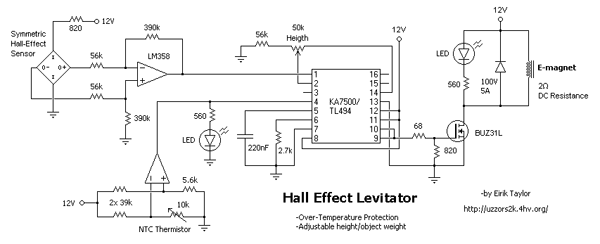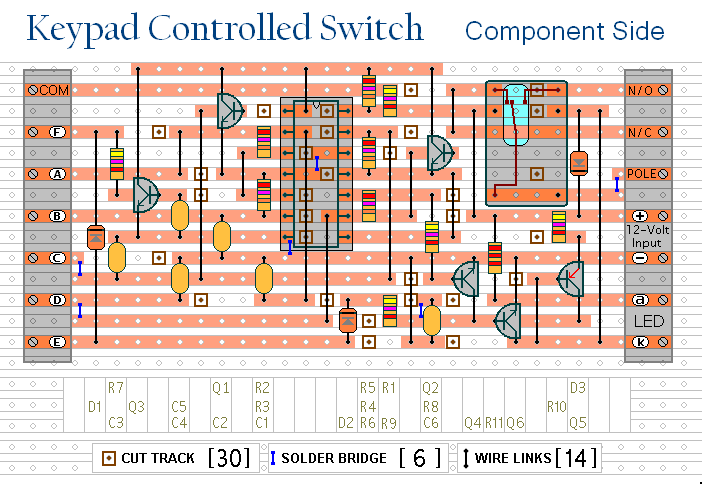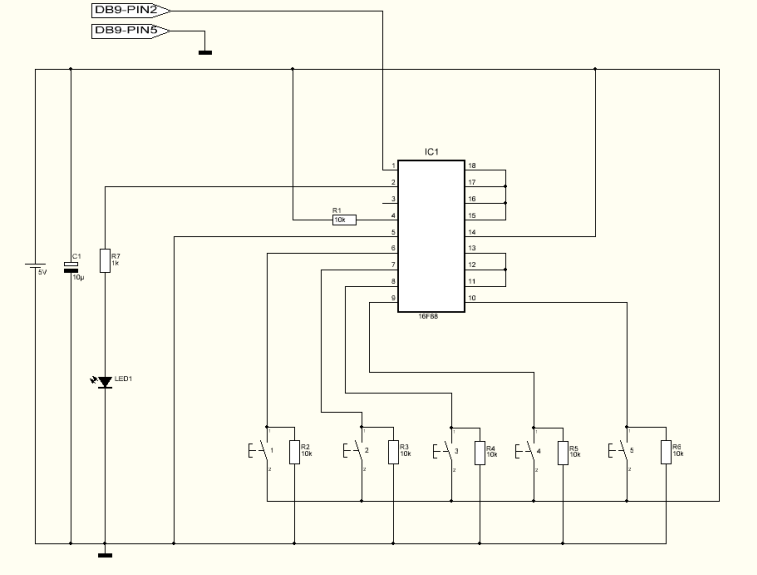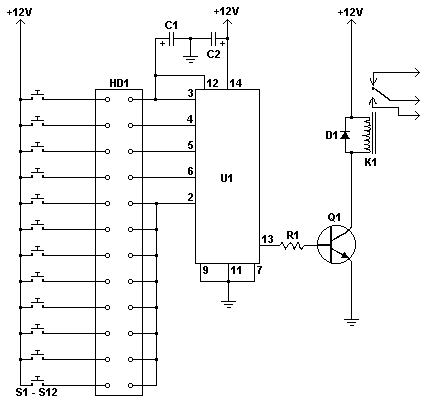
keypad floating voltages
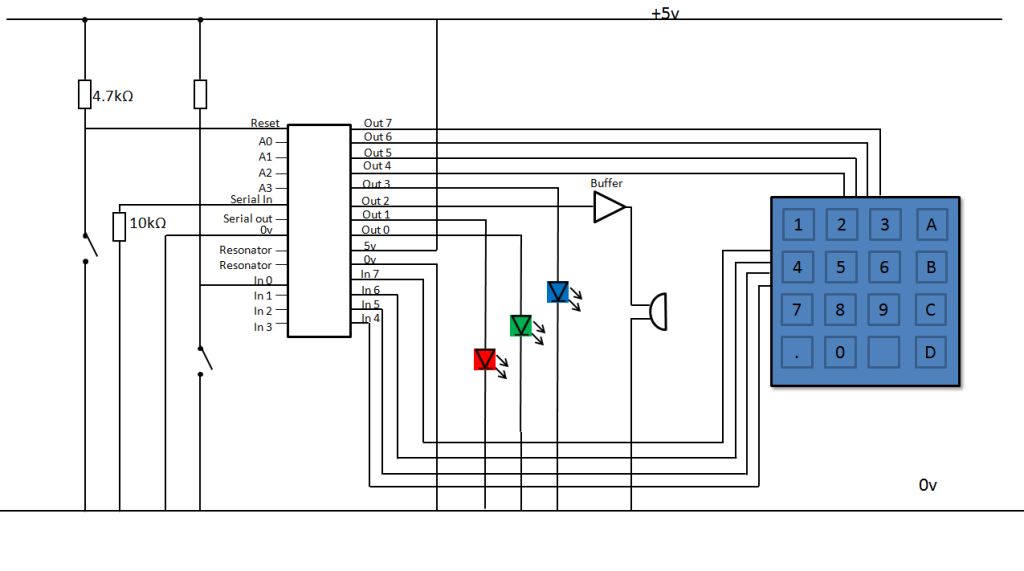
A keypad lock is being developed using a PIC microcontroller and a passive keypad with 8 pins, consisting of 4 input and 4 output pins. Each input pin corresponds to a row of numbers on a 4x4 keypad, while the output pins correspond to the numbers in that row. Activating input pin 1 results in the output pins representing the numbers 1, 4, 7, and the decimal point. Activating input pin 2 changes the output pins to represent the numbers 2, 5, 8, and 0, among others. The output from the keypad is sent to the PIC microcontroller, which processes the input. However, the keypad is advancing the program without any key being pressed, with the voltage at the PIC floating between 1V and 2.5V, which is problematic. Attempts to use a 4050 non-inverting buffer have resulted in a floating output as well. The internal pull-up resistors are not accessible since the keypad is enclosed in plastic, but it is suspected to be a PCB. To stabilize the input pins of the PIC, resistors should be connected from each of the four pins to the +5V supply, with a recommended value between 3.3K and 10K to prevent floating. The input pins are not directly connected to the 5V rail, and the only power supplied to the keypad comes from the PIC's 5V signals. When a column is activated to 5V, pressing a key in that column pulls the corresponding row pin to +5V, which the program detects as a ‘1’. Depending on the configuration, unselected columns may remain high while the selected column is pulled low. Some larger PIC microcontrollers, particularly on PORTB, offer an option to enable weak internal pull-up resistors, typically around 50K.
A comprehensive understanding of the keypad lock circuit design involves several key components and their interactions. The passive keypad is configured as a matrix, where pressing a key connects a specific row and column, allowing the microcontroller to detect which key has been pressed. The 4 input pins from the keypad are connected to the microcontroller's GPIO pins, while the 4 output pins are used to activate specific rows based on the input selection.
To resolve the issue of floating voltages at the input pins, it is essential to implement pull-up resistors. These resistors should be connected from each input pin to the +5V rail. This ensures that when no key is pressed, the input pins are held at a high logic level (5V), preventing erratic behavior in the microcontroller. The recommended resistor values of 3.3K to 10K provide a balance between power consumption and effective pull-up strength.
When a key is pressed, the corresponding output pin is activated, and the row pin is pulled low, allowing the microcontroller to read a low signal on the input pin. This process is repeated for each row, enabling the detection of multiple key presses in sequence. The programming logic within the PIC microcontroller must accommodate the fact that when a column is set to high, the corresponding row pin will also be high if no key is pressed. This requires careful programming to ensure that the microcontroller accurately interprets the key presses without false triggering due to floating voltages.
In addition to the external pull-up resistors, if the microcontroller supports weak internal pull-ups, enabling these can further stabilize the input pins. This feature can be particularly useful in applications where external components are limited or where space constraints exist. The internal pull-ups typically provide a higher resistance (around 50K), which helps to reduce power consumption while still maintaining a reliable high state on the input pins.
In summary, careful consideration must be given to the design of the keypad lock circuit, focusing on the configuration of the input and output pins, the implementation of pull-up resistors, and the programming logic within the PIC microcontroller. These elements are crucial for ensuring reliable operation and preventing issues related to floating voltages.Hey everyone. I am building a keypad lock for a project using a PIC and one of those passive keypa with 8 pins, 4 input 4 output. Each of the pins corresponds to a row of numbers on the 4 by 4 keypad, and the 4 output pins correspond to the numbers in that row.
so putting a 1 into input pin 1 will make the 4 output pins correspond to 1, 4, 7, dot. Putt ing a 1 into input pin 2 now makes 4 output pins correspond to 2, 5, 8, 0 etc. this then goes into the pic and that advances the programme etc. The problem is, the keypad keeps advancing the program without you pressing a key, the voltage into the pic floats around 1-2. 5v which I can`t get rid of. I have tried putting it through a 4050 non inverting buffer but then the output of the buffer just floats too.
it should be giving out a solid 0v or 5v, not 2. 5v I`m not sure what you mean by the weak internal pull ups, the keypad is all inside a plastic housing, so I can`t get to it, but I`m pretty sure it`s just a PCB. On the pins of the Picaxe that are used as inputs from the keypad, you need to have on each of the 4 pins a resistor from the pin to the +5V supply.
The value of the resistors can be from approx 3. 3K thru 10K, these will stop the pins from `floating`. The pins are not in anyway connected to the 5v rail though, I`m not sure how to add that in, the only power the keypad recieves are the 5v signals from the PIC For a Column that has been set to 5V by the program, will, if a key on that Column is closed, then Row pin will be pulled to +5V, which the program detects as a `1`. Note: In some cases depending upon the sense the Column is set active, it could be that the unselected Cols are all high and the selected Col is pulled low.
On many of the `larger` PIC`s on PORTB, there is an option in the configuration part of the program to enable `weak` INTERNAL pullup resistors [IIRC about 50k. ]. 🔗 External reference
A comprehensive understanding of the keypad lock circuit design involves several key components and their interactions. The passive keypad is configured as a matrix, where pressing a key connects a specific row and column, allowing the microcontroller to detect which key has been pressed. The 4 input pins from the keypad are connected to the microcontroller's GPIO pins, while the 4 output pins are used to activate specific rows based on the input selection.
To resolve the issue of floating voltages at the input pins, it is essential to implement pull-up resistors. These resistors should be connected from each input pin to the +5V rail. This ensures that when no key is pressed, the input pins are held at a high logic level (5V), preventing erratic behavior in the microcontroller. The recommended resistor values of 3.3K to 10K provide a balance between power consumption and effective pull-up strength.
When a key is pressed, the corresponding output pin is activated, and the row pin is pulled low, allowing the microcontroller to read a low signal on the input pin. This process is repeated for each row, enabling the detection of multiple key presses in sequence. The programming logic within the PIC microcontroller must accommodate the fact that when a column is set to high, the corresponding row pin will also be high if no key is pressed. This requires careful programming to ensure that the microcontroller accurately interprets the key presses without false triggering due to floating voltages.
In addition to the external pull-up resistors, if the microcontroller supports weak internal pull-ups, enabling these can further stabilize the input pins. This feature can be particularly useful in applications where external components are limited or where space constraints exist. The internal pull-ups typically provide a higher resistance (around 50K), which helps to reduce power consumption while still maintaining a reliable high state on the input pins.
In summary, careful consideration must be given to the design of the keypad lock circuit, focusing on the configuration of the input and output pins, the implementation of pull-up resistors, and the programming logic within the PIC microcontroller. These elements are crucial for ensuring reliable operation and preventing issues related to floating voltages.Hey everyone. I am building a keypad lock for a project using a PIC and one of those passive keypa with 8 pins, 4 input 4 output. Each of the pins corresponds to a row of numbers on the 4 by 4 keypad, and the 4 output pins correspond to the numbers in that row.
so putting a 1 into input pin 1 will make the 4 output pins correspond to 1, 4, 7, dot. Putt ing a 1 into input pin 2 now makes 4 output pins correspond to 2, 5, 8, 0 etc. this then goes into the pic and that advances the programme etc. The problem is, the keypad keeps advancing the program without you pressing a key, the voltage into the pic floats around 1-2. 5v which I can`t get rid of. I have tried putting it through a 4050 non inverting buffer but then the output of the buffer just floats too.
it should be giving out a solid 0v or 5v, not 2. 5v I`m not sure what you mean by the weak internal pull ups, the keypad is all inside a plastic housing, so I can`t get to it, but I`m pretty sure it`s just a PCB. On the pins of the Picaxe that are used as inputs from the keypad, you need to have on each of the 4 pins a resistor from the pin to the +5V supply.
The value of the resistors can be from approx 3. 3K thru 10K, these will stop the pins from `floating`. The pins are not in anyway connected to the 5v rail though, I`m not sure how to add that in, the only power the keypad recieves are the 5v signals from the PIC For a Column that has been set to 5V by the program, will, if a key on that Column is closed, then Row pin will be pulled to +5V, which the program detects as a `1`. Note: In some cases depending upon the sense the Column is set active, it could be that the unselected Cols are all high and the selected Col is pulled low.
On many of the `larger` PIC`s on PORTB, there is an option in the configuration part of the program to enable `weak` INTERNAL pullup resistors [IIRC about 50k. ]. 🔗 External reference
